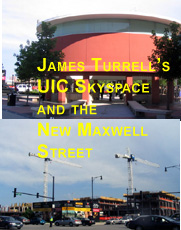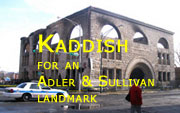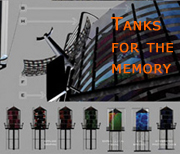| |
The era of the movie palace is one of the most incredible - and largely unexamined - periods in American history. It would have been extraordinary if only for its brevity. Structures that looked like they were built for the ages were being demolished en masse within just a few decades. Even more importantly, the movie palace was a uniquely democratic institution. All classes flocked to the movies, and the price of tickets varied by time of day, not 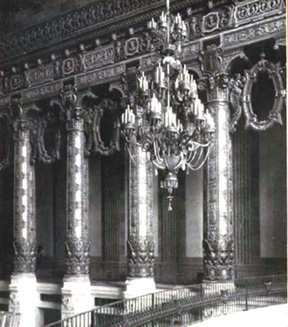 by the status of the individual seat location. At a time when streamlined Art Deco was the style of choice for skyscrapers, and a truly modern architecture based on an austere, honest expression of structure was coming into being, the movie palace was a bastion of reaction and inauthenticity, cribbing every historic style, whether it be French Baroque, medieval Guild Hall, or Egyptian temple. And yet, with this palatte of fantastical, stage set trappings, the architects of these theaters created spaces of enormous power and sense of place. by the status of the individual seat location. At a time when streamlined Art Deco was the style of choice for skyscrapers, and a truly modern architecture based on an austere, honest expression of structure was coming into being, the movie palace was a bastion of reaction and inauthenticity, cribbing every historic style, whether it be French Baroque, medieval Guild Hall, or Egyptian temple. And yet, with this palatte of fantastical, stage set trappings, the architects of these theaters created spaces of enormous power and sense of place.
It's an epic topic, one I hope to return to in the future. For now, however, the hour is late, and I will concentrate on the story of just one theater, subject of a new documentary that debuts this week.
There's no more poignant reminder of the ephemeral movie palace era than the rotting hulk of the Uptown Theater, a 4,300 seat wonder on Chicago's north side, closed since 1981, Athough an official city landmark for over a decade, for a number of years it was owned by one of the city's notorious slumlords, and still remains in private hands today, neither owned or controlled by the groups struggling to save it.
Northwestern students John Pappas and Michael Bisberg have created, Uptown: Portrait of a Palace an award-winning documentary that takes the audience through both the theater's illustrious 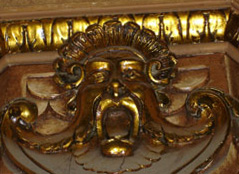 past and the more recent years of perilous neglect. The documentary will have its debut this Thursday night, June 8th, at the Portage Theater, 4050 N. Milwaukee at 8:00. The event is being hosted by Friends of the Uptown and the Portage Film Forum, who will both benefit from the proceeds. (Tickets are $8.00 in advance or $10.00 at the door.) past and the more recent years of perilous neglect. The documentary will have its debut this Thursday night, June 8th, at the Portage Theater, 4050 N. Milwaukee at 8:00. The event is being hosted by Friends of the Uptown and the Portage Film Forum, who will both benefit from the proceeds. (Tickets are $8.00 in advance or $10.00 at the door.)
Providing a note of cautious optimism, the Portage, opened in 1920, has itself recently reopened after a long shuttering. The Chicago Sun-Times recently ran a story by Mary Houlihan detailing how the Silent Film Society of Chicago took out a lease on the theater, with a hardy band of volunteers removing the tall wall that had split the 1,350-seat auditorium into two, repainted the walls and domed ceiling and even restored some of the original giltwork A gala re-opening took place earlier this month.
The website of the Friends of the Uptown includes an extraordinary, downloadable artifact: an 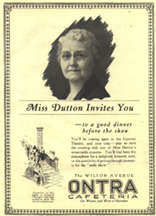 Adobe Acrobat PDF version of the complete 32 page August 17, 1925 Balaban & Katz Magazine, an issue of the weekly published by the Balaban & Katz theater chain that documents the opening of the Uptown. If ever there were a time machine, evoking the full experience of a given moment, this is it, from the ads for everything from Mrs. Dutton's Ontra Cafeteria, to the Victorola's at the Riviera Music Shop and the hand-made products of the Birdie Bauer Hat Shop, to the proud recital of the Uptown's key stats: 46,000 square feet on a full city block, 17,000 light bulbs, 10,000 pipes in the might Wurlitzer organ, $4,000,000 (in 1925 dollars) in total cost. Adobe Acrobat PDF version of the complete 32 page August 17, 1925 Balaban & Katz Magazine, an issue of the weekly published by the Balaban & Katz theater chain that documents the opening of the Uptown. If ever there were a time machine, evoking the full experience of a given moment, this is it, from the ads for everything from Mrs. Dutton's Ontra Cafeteria, to the Victorola's at the Riviera Music Shop and the hand-made products of the Birdie Bauer Hat Shop, to the proud recital of the Uptown's key stats: 46,000 square feet on a full city block, 17,000 light bulbs, 10,000 pipes in the might Wurlitzer organ, $4,000,000 (in 1925 dollars) in total cost.
The website also offers a download of the documentary's trailer, including a tantalizing shot of a 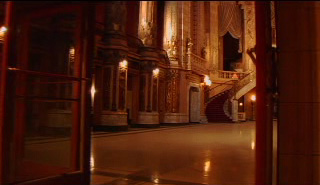 heart-stopping architectural processional that would begin with the first pulse-quickening glimpse of the sumptious interior through the doors of the outer foyer, moves, almost hypnotically, towards the warm bath of rich tones of the massive grand lobby, through the forest of soaring, intricately carved columns, beneath glittering chandeliers, up to the great curving double staircase, a portal to a nocturnal world, as in sleep, into the indelible images of a shared dream. heart-stopping architectural processional that would begin with the first pulse-quickening glimpse of the sumptious interior through the doors of the outer foyer, moves, almost hypnotically, towards the warm bath of rich tones of the massive grand lobby, through the forest of soaring, intricately carved columns, beneath glittering chandeliers, up to the great curving double staircase, a portal to a nocturnal world, as in sleep, into the indelible images of a shared dream.
Join a discussion on this story
lynnbecker@lynnbecker.com
© Copyright
2006 Lynn Becker All rights
reserved.
|
|
|

 by the status of the individual seat location. At a time when streamlined Art Deco was the style of choice for skyscrapers, and a truly modern architecture based on an austere, honest expression of structure was coming into being, the movie palace was a bastion of reaction and inauthenticity, cribbing every historic style, whether it be French Baroque, medieval Guild Hall, or Egyptian temple. And yet, with this palatte of fantastical, stage set trappings, the architects of these theaters created spaces of enormous power and sense of place.
by the status of the individual seat location. At a time when streamlined Art Deco was the style of choice for skyscrapers, and a truly modern architecture based on an austere, honest expression of structure was coming into being, the movie palace was a bastion of reaction and inauthenticity, cribbing every historic style, whether it be French Baroque, medieval Guild Hall, or Egyptian temple. And yet, with this palatte of fantastical, stage set trappings, the architects of these theaters created spaces of enormous power and sense of place.
 past and the more recent years of perilous neglect. The documentary will have its debut this Thursday night, June 8th, at the Portage Theater, 4050 N. Milwaukee at 8:00. The event is being hosted by
past and the more recent years of perilous neglect. The documentary will have its debut this Thursday night, June 8th, at the Portage Theater, 4050 N. Milwaukee at 8:00. The event is being hosted by  Adobe Acrobat PDF version of the complete 32 page August 17, 1925
Adobe Acrobat PDF version of the complete 32 page August 17, 1925  heart-stopping architectural processional that would begin with the first pulse-quickening glimpse of the sumptious interior through the doors of the outer foyer, moves, almost hypnotically, towards the warm bath of rich tones of the massive grand lobby, through the forest of soaring, intricately carved columns, beneath glittering chandeliers, up to the great curving double staircase, a portal to a nocturnal world, as in sleep, into the indelible images of a shared dream.
heart-stopping architectural processional that would begin with the first pulse-quickening glimpse of the sumptious interior through the doors of the outer foyer, moves, almost hypnotically, towards the warm bath of rich tones of the massive grand lobby, through the forest of soaring, intricately carved columns, beneath glittering chandeliers, up to the great curving double staircase, a portal to a nocturnal world, as in sleep, into the indelible images of a shared dream.
